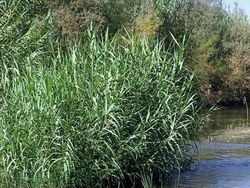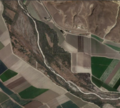Arundo donax in California's Central Coast Region

An environmental summary created by the ENVS 560/L Watershed Systems class at CSUMB.
Contents
Arundo donax: Invasive Plant
Giant reed (Arundo donax) is a perrenial invasive grass native to Eastern Asia. It is a persistent rhizomatous grass with a high biomass production and was introduced around the world as a building material [2]. When healthy, this grass can reach up to 20 feet in height with long, flat, green leaves. It is considered an ecological threat since it spreads when its rhizomes come in contact with soil within wetlands. This grass spreads along riparian zones and lake shores, contending with native vegetation for sunlight, water, and nutrients [3].
Arundo donax in the Central Coast

Arundo donax (Arundo) was orginally introduced in California during the 1820's as an erosion control agent in an effort to maintain stream bank stability along drainage channels[5]. Since it introduction, this reed has been spreading through Central California watersheds, affected areas such as Monterey and San Luis Obispo counties, as well as the San Francisco Bay, Sacramento and San Joaquin Rivers [6]. By 2008, approximately 1,900 acres of the 4,160 sq miles of the Salinas Watershed was encroached with Arundo, before control programs were set in place to treat the stands along the Salinas River (Figure 2) [4]. After the implementation of control programs, approximately 1,400 acres of Arundo remain in 2017 (pers. comm., E. Zefferman, RCDMC). The highest levels of invasion along the Salinas River have been observed in vegetated floodplains, vegetated low terraces, and vegetated upper terraces, similar to San Luis Rey, Santa Ana, Santa Clara, Santa Margarita, and Ventura River [7]. The Salinas watershed Arundo patches are less continuous and lack the connectivity often displayed in other impacted watersheds across the state [7].
Without the application of removal effects Arundo growth will continue unimpeded, contributing to the negative effects associated with excessive plant growth along riparian corridors, including flooding, fires, and habitat loss.
Flooding in Central Coast
The Salinas River has a long history of floods dating back to 1911. The growth of Arundo can exacerbate these effects by altering the direction of water flow and influencing river discharge. Thick patches of Arundo can obstruct the natural flow of a river, forcing water to find an alternative pathway, potentially impacting neighboring farmland and private properties [8].
Fires
High areas of biomass also increases the risk and severity of fires along riparian corridors[9].
Habitat Loss
As Arundo donax spreads, individual clusters become interconnected, producing a monoculture cane wall that stifles the growth of indigenous riparian species [5]. Arundo grows in large clustered patches, competing with native species such as willows, mulefat, and cottonwoods, reducing wildlife habitat for a range of native and migratory species[5]. In addition to providing minimal nutritional values and insufficient habitat structure, Arundo also limits the production of aerial insects, causing serious implications for many of California's already threatened insectivorous bird populations, such as the Least Bell’s vireo (Vireo bellii pusillus) and southwestern willow flycatcher (Empidonax traillii extimus)[7].
Local Solutions to Arundo Invasion
The two groups that are addressing the encroachment of Arundo in the Central Coast region are the Resource Conservation District of Monterey County (RCDMC), and the Monterey County Water Resources Agency (MCWRA) [4]. The Monterey County Agricultural Commissioner began treating the Arundo by implementing spraying of scattered patches in the upper watershed (pers. comm., E. Zefferman, RCDMC). In 2011 the California Invasive Plant Council (CalIPC) prepared an Arundo donax Distribution and Impact Report in agreement with the State Water Resources Control Board (SWRCB)[7].
In 2014 the RCDMC took over the responsibility of maintaining Arundo growth in Monterey County, which they began by conducting an initial study in accordance with the California Environmental Quality Act (CEQA), detailing the current extant of the problem in the Salinas Watershed. The Initial Study resulted in a Mitigated Negative Declaration submitted to the California Department of Fish and Wildlife (CDFW) for the Salinas River Watershed Invasive Weed Control and Restoration Program, which is currently being implemented by the RCDMC in collaboration with the CalIPC [10].
Arundo Control Methods
As stated in the Salinas River Watershed Invasive Weed Control & Restoration Program[9], the RCDMC uses the following methods of control the regional spread of Arundo:
- Chemically treat with broad-spectrum and target-species specific herbicides including glyphosate, imazapyr, or triclopyr, and will be formulated for approved use nar water bodies using backpack sprayers or hand-held power sprayers [9].
- Removal of dead stands by mowing with attachments, by hand and carried to chippers
Mitigation Measures [9].
The Streambed Alteration Agreement under the Initial Study clearly outlines restriction regarding the "take" of any threatened species including the San Joaquin Kit Fox, South-Central California Coast Steelhead, Monterey roach, Tidewater Goby, California Red-Legged Frog, sensitive plant species, California Tiger Salamander, Western Spadefoot, Pacific Pond Turtle and Foothill Yellow-legged Frog, Burrowing Owl, Least Bell's Vireo, and the American Badger. Mitigation measures are implemented throughout the duration of the project to avoid take of the previously stated threatened species, as well as any addition fish or wildlife that could may be affected during Arundo removal.
Removal efforts also take the protection of native plant species into consideration when implementing mitigative strategies to remove Arundo from riparian corridors. Species specific herbicides are used when possible to avoid broad spectrum eradication. After removal of Arundo, native plants, such as willows and the California sycamore, are restored in regions that are prone to erosion in an effort to maintain stream bank stability [9]. The rest of treated riparian areas are naturally restored (pers. comm., E. Zefferman, RCDMC). With erosion as a concern before and after Arundo control treatment around the Salinas River, the Initial Study also limits vehicular operations for up to 24 hours after large rain events that would make riparian region soil more prone to erosion.
Future of Arundo
Since the Salinas River watershed has the second-largest infestation of California, RCDMC has implemented the Arundo Control Program since 2014, to control all Arundo by the year 2028 [4]. Many stakeholders have been collaborating with RCDMC and private landowners in Monterey County, in order to restore native riparian vegetation. The RCDMC Control Program has been successful and treated a significant amount of Arundo since 2014 and bettered the river system with the help of private landowners, as seen in Table 2. As on April 2020, RCDMChas initiated treatment on approximately 650 acres. Private landowners have initiated treatment on almost 100 acres under the Salinas River Maintenance Program.
| Table 2. Initial Acerage of Treated Arundo in Salinas River Watershed per Year (pers. comm., E. Zefferman, RCDMC) | |
|---|---|
| Year | Acerage of Arundo Treated |
| 2014 | 113 |
| 2016 | 103 |
| 2017 | 120 |
Satellite
As seen in these Landsat 8 satellite land cover images, the Arundo invasion is under control since the start of the control programs.
References
- ↑ / CALIPC (California Invasive Plant Council). Arundo donax. Cal-IPC.
- ↑ / Pilu R, Bucci F, Badone FC, Landoni M. 2012. Giant reed (Arundo donax L.): A weed plant or a promising energy crop? African Journal of Biotechnology 11(38) 9163-9174.
- ↑ / Swearingen J, Bargeron C. 2016. Invasive Plant Atlas of the United States. University of Georgia Center for Invasive Species and Ecosystem Health.
- ↑ 4.0 4.1 4.2 4.3 / RCDMC (Resource Conservation District of Monterey County). Salinas River Arundo and Tamarisk Control. Salinas River Watershed Arundo Control Program.
- ↑ 5.0 5.1 5.2 Gary P. Bell, Biology and growth habits of giant reed (Arundo donax)
- ↑ / Wessel, Lindzi. 2016. Arundo: The invasive 'hair clog' of the Salinas River. The Californian..
- ↑ 7.0 7.1 7.2 7.3 / CALIPC (California Invasive Plant Council). 2011. Arundo donax Distribution and Impact Report. State Water Resources Control Board.
- ↑ / Spencer DF, Colby L, Norris GR. 2013. An evaluation of flooding risks associated with giant reed (Arundo donax). Journal of Freshwater Ecology 28(3) 397-409.
- ↑ 9.0 9.1 9.2 9.3 9.4 / CDFW (California Department of Fish and Wildlife. 2014. Notice of Determination. Salinas Watershed Invasive Non-Native Plant Control (Project). RCD Monterey
- ↑ / RCDMC (Resource Conservation District, Monterey County). 2014. Attachment E-Regulatory Documentation. Salinas River Watershed Invasive Weed Control and Restoration Program. RCDMC.
Links
- Monterey County Water Resources Agency (MCWRA)
- State Water Resources Control Board (SWRCB)
- California Environmental Quality Act (CEQA)
- Resource Conservation District, Monterey County (RCDMC)
Disclaimer
This page may contain student work completed as part of assigned coursework. It may not be accurate. It does not necessary reflect the opinion or policy of CSUMB, its staff, or students.

